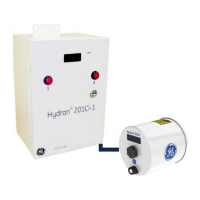In a Modbus network architecture every slave unit is identified by its unique address.
The master device relies on these specific addresses in order to identify the slave station
it communicates with. The slave does not respond to requests issued by a master unless
the address embedded in the Modbus telegram matches its own address (broadcast
telegrams are discarded).
J.2.2 Data Link Layer
Communications take place in packets which are groups of asynchronously-framed
byte data. The master transmits a packet to the slave and the slave responds with a
packet. The end of a packet is marked by a dead time on the communications line.
Section J.2.3 below details the general format for both transmit and receive packets.
For more details on packet formatting, refer to subsequent Sections describing each
function code.
J.2.3 Modbus RTU Packet Format
Table J-1 below presents the size of the Modbus RTU packets.
• Slave Address: Identifies the slave device intended to receive and process the
packet. Each slave unit has a unique address in order to prevent bus
contention. A slave device only responds to communication packets including
its own address.
Table J - 1: Size of the Modbus RTU Packets
• Function Code: Indicates one of the implemented function codes; see Section
J-3.a for complete details. An exception response from the slave is indicated
by setting the high-order bit of the function code in the response packet; see
Section J-3.b for further details.
• Data: Contains a variable number of bytes depending on the function code
and the nature of the data to be transmitted. This may include actual values,
settings, or addresses sent by the master to the slave or by the slave to the
master.
• CRC: This is a 2-byte error checking code. The RTU version of Modbus
includes a 16-bit Cyclic Redundancy Check (CRC-16) with every packet, which

